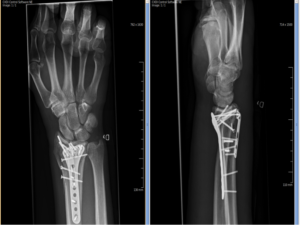
Wrist Fracture Surgery fixes and realigns broken bones in the wrist to allow them to heal properly. Tools such as screws and pins might be used to keep the bones in place.
What is it?
A wrist fracture can occur at all ages. Children can break their wrists through horseplay and sports, while adults and seniors are more susceptible to breaks caused by falls and traumas. There are ten bones located on the wrist, and each can be broken a different way. The severity of the fracture will determine whether the person might need surgery to repair the fracture. The surgery will help to remove any dead bone or bone fragments that cannot be used to fix the fracture. If a bone punctures the skin, surgery will clean out the wound and help to prevent infection. Wrist fracture surgery will also align and secure the bones in their proper place.
What should I do to prepare?
Preparing for any surgery can be stressful. It is best to understand and talk with your doctor about what will happen during the surgery and what to expect after it is complete. Having a family member or close friend with you the day of surgery can help alleviate some stress. Scans and preoperative testing will be conducted to determine the best approach to fix the fracture in the wrist. A patient should not eat or drink after the midnight before surgery. Rest and immobilization may be necessary post-surgery to help in the healing process. This may require time off from work and other physical activities.
What happens during the process?
Open fractures or a crush injury will most likely require surgery to fix the breaks in the wrist. A combination of pins, screws, plates, and wires are used to set and stabilize the fractured pieces of bone. The area around the fracture is cleaned to make sure no bone fragments or any foreign objects are in the surrounding tissue. Open fractures are more prone to infection since the bone is exposed to open air. Once the fracture is set back into the correct position, the incision will be closed and bandaged up.
What are the risks and possible complications?
Any surgery involving bones, muscles, or tendons will pose a risk for re-injury or injury to another part of the surrounding area. Infections, bleeding, and numbness or tingling are possible with this surgery. Weakness and loss of function are also a possibility with Hand Fracture Surgery. There is also the chance that there will be damage to blood vessels and nerves within the wrist. There is the chance that further surgery may need to be done later down the road to remove any excess bone growth that occurs during the healing process.
Disclaimer:
All GlobeHealer Site content, including graphics, images, logos, and text, among other materials on the site are only for education purposes. This content is not intended to be a substitute for professional medical advice, and you should always contact your physician or qualified health provider for information regarding your health. Information on this site regarding the overview, diagnosis, and treatment of any kind should be looked at, in addition to the advice and information of your health care professional. Do not disregard medical advice or delay seeking treatment or medical advice due to information found on the GlobeHealer site.
If there is even the possibility that you may have a medical emergency, seek treatment, call your doctor, or call your local emergency telephone number immediately. GlobeHealer does not endorse being the first line of communication in case of emergency and does not endorse any specific test, physician, facility, product, procedure, opinion, or other information that is or may be mentioned on this site or affiliated entities. Reliance of any and all information provided by GlobeHealer, its employees, affiliations, others appearing on the Site under the invitation of GlobeHealer, or visitors of the site is solely at your own risk and is not the responsibility of GlobeHealer.
Image Source:
